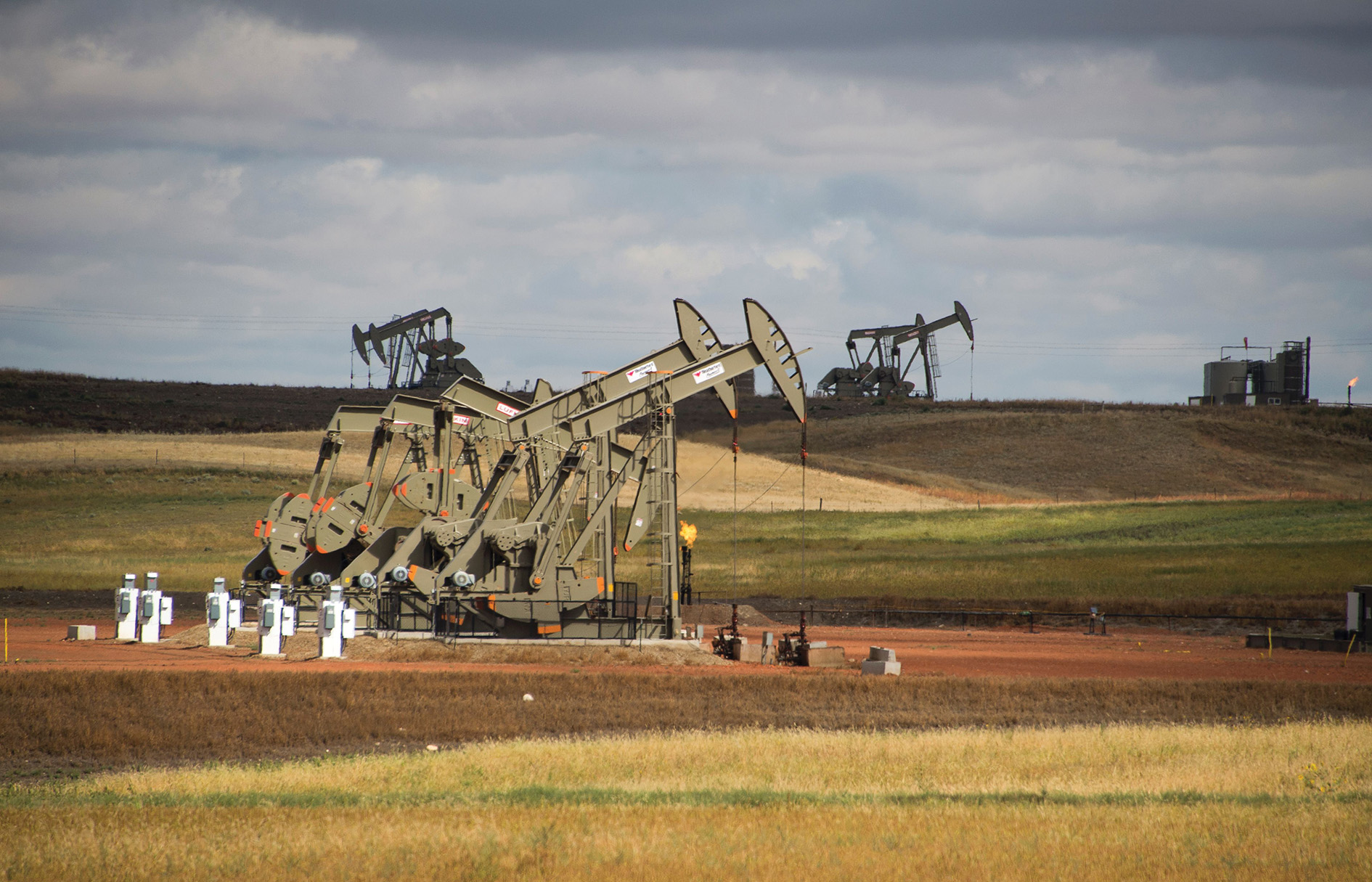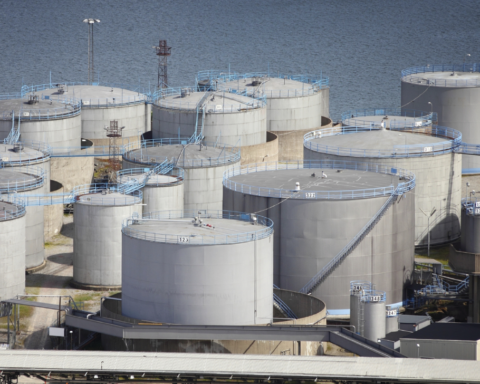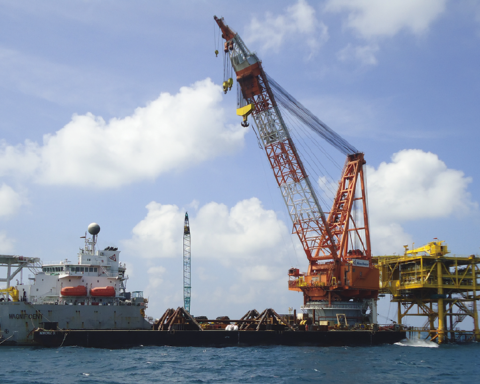Sergey Vakulenko
Head, Strategy and Innovation Department, Gazprom Neft
UDC 339.16: 665.61
Abstract. We can already say that 2020 will go down in the history of oil industry alongside the crisis years of 1973 and 1986. The turmoil in the oil market probably surpasses everything that has happened to it in the retro-seeable past. It would be much easier to evaluate and analyze all the events after a while, and for sure many articles and books will be written about them, but the first conclusions and assessments can be made right now.
Keywords: oil, crisis, falling demand, epidemic.
The oil industry is facing the perfect storm – the outbreak of a trade war in the market, fueled by controversies in the OPEC+ consortium and a sharp, unprecedented drop in demand due to measures to counter the COVID-2019 epidemic. While the pandemic and the crisis it caused is a natural disaster with all the ensuing consequences for the modern integrated world[1], the conflict in the oil market has been brewing for a long time. The origins of the current events were resting dormant in 2014.
Unhealthy recovery
Quickly recovering from the fall in prices after the 2008 crisis, the oil market was booming, with oil prices steadily staying at $ 100–110 per barrel. This gave impetus to the rapid development of shale production in the United States. From 2008 to 2014, production in the United States increased from 5 million barrels per day in 2008 to 8.8 million barrels per day in 2014. At the same time, it became clear that shale oil production would only grow in the future. Supply began to outstrip demand, and in the summer of 2014 a significant decline in prices had started, dropping to $ 80 per barrel by autumn. At a meeting in November 2014, the OPEC countries faced a dilemma: either reduce their production from the then level of 30 million barrels per day, yielding a market share to the US shale producers, but maintaining a high price, or allow competition. The poorer OPEC members, with relatively little production but dependent on oil revenues, asked for cuts, but the Arab Gulf states, primarily Saudi Arabia, insisted on competition. Saudi Arabia’s oil minister al-Naimi believed the market needed a recovery and the high price created volatility. Looking back, one might rather wonder why the market did not see the imbalances being created earlier. By 2014, a significant increase in oil reserves stored began, but apparently the market believed that OPEC would continue to support the price by reducing its own production.
Indeed, 2014 was somewhat similar to 1986. Then, the high prices that formed after the change in the market structure in 1973, the Islamic revolution in Iran, the Iran-Iraq war, gave rise to a new class of reserves and a new type of production. It was at these prices that the development of offshore fields in the North Sea and the Gulf of Mexico became commercially viable. At first, offshore production was extremely expensive, but gradually, as investments in technology increased, the accompanying infrastructure developed, onshore bases in New Orleans, Aberdeen and Stavanger, the efficiency of manufacturers of equipment for offshore production, etc. increased, it became cheaper and accessible to more players. As a result, since 1983, production growth has significantly outstripped demand. Saudi Arabia tried to maintain prices by cutting its production from 10 million bpd in 1980 to 3.7 million bpd in 1985, but it didn’t help either. In 1986, Saudi Arabia increased production by one and a half times, to 5.2 million barrels per day, and by 1992 brought it to 9 million barrels per day. As a result, oil prices fell by half, from $ 27 in 1985 to $ 14 a barrel in 1986. In today’s money, that would be an analogue of 65 and 33 US dollars per barrel. But the oversupply kept prices low for another 15 years, until the early 2000s.
Mutual interest deal
With that lesson in mind, Saudi Arabia did not want to create a climate for unnecessary investment in production capacities. The fall in prices by 2016 was a shock for the oil industry. The price of a barrel of oil fell to $ 27. Indeed, the US shale production slowed down somewhat, the industry as a whole made great efforts to cut costs, and low prices became quite painful for the producing countries in the result.
It was then that contacts began between Saudi Arabia and Russia. On the one hand, OPEC countries were unhappy that other large producers were taking advantage of the cartel’s efforts to maintain prices without paying with a decrease in their production for it. In addition, OPEC’s share in world production has dropped significantly compared to 1970–1980, and in order to noticeably change the level of world supply, OPEC is forced to cut its production too much. Other large players joining the alliance would make the specific production cut more acceptable to all members. On the other hand, Russia has an understanding that it has become a major player in the world market and can participate in correcting imbalances.
In 1998, after the Asian crisis, when oil prices dropped below $ 10 per barrel, there was an attempt to invite Russia to participate in saving the market and cutting production, but then the government was rather weak, and the industry was much more decentralized and privatized. Even if politicians were able to agree on coordinating actions with OPEC, it would be very difficult to put this agreement into practice. In addition, Russia was just beginning to recover its production, which had fallen by half since the peak of the mid-1980s, so the idea of limiting it was not very popular.
By the fall of 2016, informal negotiations made possible the creation of the OPEC+ alliance, in which Russia became a key player on the part of the countries that do not belong to the cartel. The main task of cooperation was declared to be a temporary reduction in production in order to eliminate imbalances and warehouse leftovers accumulated in 2009–2014. The alliance claimed that it did not intend to control the oil price as such, but only wanted to reduce market volatility.
From the very beginning, the attitude of market players to the deal to limit production was rather mixed in Russia. On the one hand, low prices were painful for oil companies, and on the other their strategy was based on continuous growth, increase in scale and independence in making decisions regarding their resource base for 20 years. It was this story that was sold to investors, the internal structures of the companies were focused on this, and managers’ ambitions remained behind each successful corporate and production growth. Nonetheless, the 2016 price levels were painful enough and the deal looked acceptable.
The level of participation offered to OPEC+ countries, mainly Russia, was significant, but not too large. It was more important for the OPEC countries and Saudi Arabia to demonstrate a broad coalition of the parties to the deal and to ensure that Russia and other non-OPEC countries would at least abstain from increasing production.
Russia got a reduction quota of 300 thousand barrels of oil per day against the level of October 2016. Saudi Arabia, a country with a comparable level of production, decreased by 486 thousand barrels per day at the end of 2016, and then undertook and met its additional voluntary cutback commitments several times. In addition, during the period of the deal, there were problems in Venezuela, sanctions on Iran, the civil war in Libya, which together removed several million more barrels of oil from the market. As a result, for example, Nigeria and Iraq were allowed to even increase production. The members of the cartel understood the position of these countries that were facing political and socio-economic problems and declared that their production at the time of the transaction was below their natural fair levels.
In general, the agreement was respected by all members, much better than during the previous iterations. Russia also complied with it, reducing production from 11.25 million barrels per day to 10.95 million barrels per day. There were months when Russia could meet the agreement by 80% (that is, produce not 10.95 million barrels per day on average per month, as promised, but 11.01 million barrels), but the overall level of compliance was quite high. Such fluctuations were caused by the technical peculiarities of accounting for produced oil. Russia was the only country in the OPEC+ deal, whose reduction quota was calculated based on the amount of oil and gas condensate production. The volume of condensate production is related to the volume of gas production, and they are associated with fluctuations in consumption within the country and on foreign markets. And these indicators are difficult to predict. On the other hand, Saudi Arabia has also increased its production, for example, in the summer, when there is an increase in electricity consumption and oil goes to power plants. The success of the deal was also aided by the development of modern technologies for monitoring and recording oil production in real time, which was impossible 20 years ago.
The difference in views
By the end of 2018, the goal of reducing commercial inventories around the world was achieved. At the same time, prices began to rectify and then the renaissance of American shale oil became noticeable. The US oil industry went through a tough time in 2015–16 by dramatically reducing costs and improving drilling efficiency. This made it possible to increase production significantly. For the members of the OPEC+ alliance, the time had come to think about what to do next. At that point, friction began to be felt between the two key players in the “big cartel”. Each time Saudi Arabia found a reason to propose at least an extension of the agreement to cut production, and as a maximum, to increase the quotas for that reduction. Against the background of a fairly rapid growth in global demand (in two years it grew by more than 3 million barrels per day), this began to irritate Russian oil workers. Saudi Arabia itself voluntarily reduced its production more than the agreement required, but in the end, it was less and less pleased to bear this burden alone.
It became clear that the goal of Saudi Arabia was precisely to maintain the price at a certain level of $ 70–80 per barrel. These 70–80 dollars were needed, in particular, for the successful IPO of the national company Saudi Aramco at the price that was originally announced. After the company’s shares were placed on the stock exchange, it became necessary to maintain the value of securities above the IPO price. Anyway, money was needed to carry out an extensive program of transformation, conceived by Crown Prince Muhammad bin Salman.
Keeping production at a plateau, ro say nothing of further cuts, ran counter to the ambitions of Russian oilmen and the country’s fundamental view of oil market, which is that the price of $ 70–80 is volatile and unprotected. At such a price, shale production starts to develop too rapidly, and expensive projects are launched, for example, on the deep-water shelf of Brazil and Guyana. As a result, OPEC would face a dilemma – either reduce its production, yielding the entire increase in global demand to new players and creating comfortable conditions for them, or face a significant drop in prices. The irony is that in such a paradigm, Saudi Arabia’s voluntary actions to cut its own production and push prices up, while being free to other market participants, can bring in a lot of revenue at the moment, butbecome counterproductive and cost-destroying in the long run.
Non-market gap
In September 2019, the architect of the OPEC+ deal, Khalid al-Falih, was replaced as Saudi Arabia’s oil minister by Prince Abdulaziz bin Salman.
In November 2019, at the OPEC+ meeting, it was discussed that quotas should be weakened on formal grounds (reduction of oil stocks in warehouses to an average over 5 years). Nevertheless, it was decided that on the eve of winter, when traditionally the demand for oil and oil products is low, this should not be done, but in March it would look the most logical decision.
Preparations for the OPEC ministerial meeting take quite a long time. The technical committee, at which the positions of the parties are announced for the first time, was held in early February. At that moment, the situation with the coronavirus did not look threatening at all. It looked like the disease zone was limited to China and even in China it was declining. Real information about the demand for oil products comes with a lag of 2–3 months, especially when it touches to a fairly closed China. So, it would be possible to estimate how much Chinese demand actually decreased, how much the balances in storage facilities actually increased because of this, it would be possible only in a few months. At the same time, in the previous six months, US shale production has already shown a slowdown and faced some difficulties. In spring, demand traditionally begins to grow. In such circumstances, even keeping production at the previous level would be a move aimed at fortifying prices. On the other hand, the position of Saudi Arabia was getting tougher. At first, it was about an additional reduction by 600 thousand barrels per day, of which a third was to come from Russia. Already in February, Saudi Arabia made it clear that the alternative to the cut would be a complete termination of the deal with a sharp increase in production.
By early March, the situation with the coronavirus in the world as a whole still looked under control, but there were already concerns about a possible slowdown in the global economy due to a two-month halt in China (and a corresponding reduction in Chinese GNP). In such a situation, OPEC+ members would be more inclined to curb production, and Saudi Arabia actually proposed doubling the rates. The threat of a total quota abandonment and a price war was stronger in these circumstances. As a condition for not using this threat, Saudi Arabia proposed a deep cut in total production by 1.5 million barrels per day by the end of the year. The duration and depth of this contraction at that moment meant creating a deficit in the market and pushing prices up. In fact, Saudi Arabia tried to threaten to force the rest of the OPEC+ members to accept their model of oil market and price management.
Russia’s neutral proposal to postpone the discussion for a month until the situation on the markets would clarify was in fact a rejection of the ultimatum. To save face, Saudi Arabia used what is called the atomic option. The Kingdom announced that the existing OPEC+ deal, and ipso facto, the agreement on quotas of OPEC countries were to expire on March 31, appeared impossible to agree on new levels, participating countries were not bound by obligations to limit production any more.
Looking back, we can say that time worked against the negotiators. Just a week later, on March 13th, when news of COVID outbreaks began to arrive in Europe and the United States, it became clear that it was not possible to contain the epidemic to China. More and more countries started imposing strict quarantine measures. The positions of the parties would have been different against that background. But history does not know any subjunctive mood. In my opinion, the version that Saudi Arabia was the most perspicacious and foresaw a sharp decline in demand in advance is also unfounded. Nobody foresaw this in February, no such arguments were put forward.
War of proposals
The very next day after the failed meeting in Vienna, Saudi Arabia declared a price war. In addition to the statement about increasing production, high discounts were announced for the Kingdom’s oil with the direction of supplies to Europe. In fact, Saudi Arabia has decided to do its best to market its volumes at the expense of Urals and make it difficult to sell Russian oil on its traditional markets.
The pricing mechanism for Saudi oil is quite specific. The principle of its implementation is that oil is sold only to end consumers, with a ban on resale. The price of oil is different for each market. It is determined by the monthly announcement of a discount or mark-up for different grades of Saudi oil relative to the market price of a benchmark grade of the respective region. For supplies to the Mediterranean and North Sea ports, this grade is Brent, and the defining quotation is the price of futures for the next traded month (for April it is June) traded in the month of shipment.
Usually, the purpose of a discount or mark-up is to balance the value of Saudi oil for the buyer with respect to the benchmark grade, taking into account the freight cost from the Persian Gulf to Europe and the difference in the value of different grades of Saudi oil against Brent to the refiner at a given time. But while the discount for Arab Light is usually $ 2–3, in March 2020 it was announced at more than $ 10 per barrel.
It was this discount, much more than the announcement of additional volumes, that triggered the price collapse.
Bifurcation point
As it turned out, literally two weeks later, the world oil market faced a much more serious shock, possibly comparable or even exceeding in scale the embargo announced in 1973 by Arab countries on oil supplies to the United States, Canada, Great Britain, the Netherlands and Japan. This time, the shock was not on the supply side, but on the demand side. By early April, more than 150 countries, in which most of the world’s population lives, producing 80% of global GDP, were under quarantines of varying severity. Air transportation had more than halved; in many countries road transportation had decreased by 80%. Estimates of the drop in global oil demand range from 15 to 35 million barrels per day, which is significantly higher than the additional volumes that can be put on the market by all OPEC+ participants.
Already, Saudi Arabia, like all other market participants, are facing difficulties trying to place their volumes. So far, the futures market is strong enough and the far end of the futures curve – the prices for oil supplies in 18–24 months – have remained approximately where they were before the shocks, about $ 50 per barrel. Therefore, now, despite the drop in demand, traders continue to buy oil, place it in storage facilities and fix profits by selling it on the futures market. But with such a rate of filling the storage facilities, this scheme will become impossible in June, and storage prices are starting to go down.
The situation is aggravated by the fact that at the moment it is difficult to predict how long the quarantines will last, whether it will be possible to really overcome the epidemic in two months, how it is now planned, how deep and prolonged the economic recession in which the world will find itself as a result will be, how fast and complete the recovery will be. Already in early April (taking inflation into account), prices approached the levels of 1998, and their further dynamics depends on whether it will be possible to create a broad coalition of oil producers who are ready to limit their production. The volume of cuts required to stabilize the prices around $ 30 per barrel instead of bringing them back to the February 2020 level, is too large for a small group of producers.
Under these circumstances, the OPEC+ participants, apparently, will not be able to increase production in April 2020 as planned. The sharp drop in prices should lead to a significant reduction in US production, possibly by 1–2 million barrels per day in 9–12 months. This will be driven by a combination of a sharp decline in new drilling in shale reserves due to inefficiency and rapid decline in production inherent in shale wells. The natural decline in shale oil production will not be completely replaced by production from new wells.
The later an agreement on production cuts is reached, the smaller the decline in production, the longer the global economic recovery, the longer the resulting excess of oil in storage, which is likely to exceed the surplus of 2014 significantly.
Some analysts are already predicting a massive decline in investment, which will lead to a shortage of oil in 2–3 years and a significant rise in prices. But for that model to be correct, rapid growth of both the economy as a whole and demand is necessary, which is by no means guaranteed.
All oil companies in the world are now trying to solve three problems: how to organize their work under the conditions of quarantine and the threat of epidemics at their production sites; how to live for several months in the conditions of a fundamentally different level of demand for both crude and petroleum products, and what to do then, during the period of recovery in demand offset by very low prices. Companies were able to significantly reduce their costs in 2015–2016, but there is no certainty that they will be able to repeat this now, as the cost reduction should be even more pronounced. Corporations will have to make a difficult choice between the targets in their portfolio: the prospects for many projects will be dimmed badly by the decrease in forecast prices, and if investments in such projects continue, companies will have to convince themselves and their shareholders of the prospects of situation improvement. All that will only make sense provided that they have enough capital to maintain the volume of investment, which will not be the case for many.
Finally, the governments and economies of many
countries dependent on oil rent find themselves in a doubly difficult position.
For all countries of the world, getting out of the crisis, recovering economies
after a forced shutdown, and helping those affected by the closure of business
will be a difficult task. But oil-producing countries will face an additional
steady decline in their income.
[1] I avoid calling the COVID-2019 pandemic a “black swan”. Scenarios of such a pandemic have been repeatedly described, both in scientific papers and documents of authoritative research and expert centers, as well as in fiction and cinema. The World Economic Forum has for many years identified the global pandemic as one of the significant risks to the global economy. Thus, both the pandemic itself and its consequences were quite an expected event, unlikely for any given year, but quite probable on the event horizon of 10–20 years.







